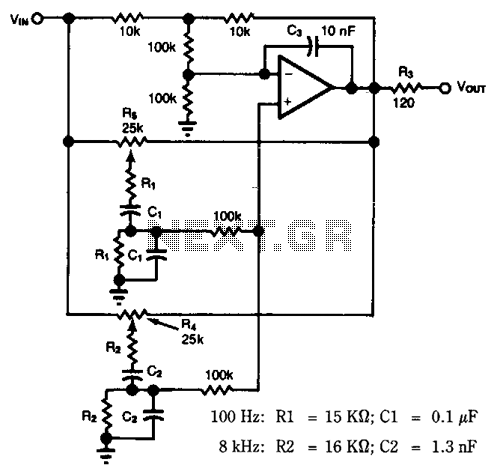
Wien-bridge-filter

Most audio tone controls affect midband gain and often create booming or hissing sounds when activated. These problems can be avoided by using a dual Wien-bridge filter to provide independent control of the treble and bass frequencies. Experiments with equalizers indicate that the optimum center frequencies are approximately 100 Hz and 8 kHz. Using the relation f = (21fRC)^-1, set the values in Figure 1 accordingly: for 100 Hz, R1 = 15 kΩ and C1 = 0.1 µF; for 8 kHz, R2 = 16 kΩ and C2 = 1.3 nF. R3 and C3 provide stability. A ±9 dB variation of treble and bass can be achieved by adjusting potentiometers R4 and R5, respectively. The filter's frequency response is illustrated in Figure 2.
The dual Wien-bridge filter is an effective circuit design for audio tone control, providing a precise means of adjusting treble and bass frequencies without introducing undesirable artifacts such as booming or hissing sounds. This filter employs two separate branches, each tuned to the desired frequency range, allowing for independent adjustments.
The choice of center frequencies at 100 Hz for bass and 8 kHz for treble is based on empirical data from equalizer experiments, which suggest these points yield optimal sound quality for most audio applications. The resistors and capacitors used in the circuit are critical for determining the cutoff frequencies. The formula f = (21fRC)^-1 facilitates the calculation of these components. For the bass control, a resistor R1 of 15 kΩ paired with a capacitor C1 of 0.1 µF establishes the 100 Hz cutoff. Similarly, the treble control is set with a resistor R2 of 16 kΩ and a capacitor C2 of 1.3 nF to achieve the 8 kHz cutoff frequency.
To ensure stability in the filter operation, additional components R3 and C3 are incorporated, which help mitigate potential oscillations and maintain consistent performance across varying loads. The design allows for a treble and bass adjustment range of ±9 dB through the use of potentiometers R4 and R5, enabling fine-tuning of the audio output to suit individual preferences or specific acoustic environments.
The frequency response of the filter, as depicted in Figure 2, illustrates how the gain varies with frequency, confirming the effectiveness of the design in achieving the desired audio characteristics. This comprehensive approach to tone control ensures high fidelity and user satisfaction in audio applications.Most audio tone controls affect midband gain, and !bey often create booming or hissing sounds when activated. You can avoid tbese problems by using a dual Wien-bridge filter to provide independent control of tbe treble and bass frequencies.
Experiments witb equalizers indicate that tbe optimum center frequencies are about 100 Hz and 8 kHz. Using the relation/= (21fRC)-1, set the Fig. 1 values accordingly: 100Hz: R1 = 15 KO; C1 0.1 p,F 8kHz: R2 = 16 KO; C2 1.3 nF R3 and C3 provide stability. You obtain a ±9 dB variation of treble and bass by adjusting potentiometers R4 and R5, respectively.
The filter"s frequency response is shown in Fig. 2. 🔗 External reference
The dual Wien-bridge filter is an effective circuit design for audio tone control, providing a precise means of adjusting treble and bass frequencies without introducing undesirable artifacts such as booming or hissing sounds. This filter employs two separate branches, each tuned to the desired frequency range, allowing for independent adjustments.
The choice of center frequencies at 100 Hz for bass and 8 kHz for treble is based on empirical data from equalizer experiments, which suggest these points yield optimal sound quality for most audio applications. The resistors and capacitors used in the circuit are critical for determining the cutoff frequencies. The formula f = (21fRC)^-1 facilitates the calculation of these components. For the bass control, a resistor R1 of 15 kΩ paired with a capacitor C1 of 0.1 µF establishes the 100 Hz cutoff. Similarly, the treble control is set with a resistor R2 of 16 kΩ and a capacitor C2 of 1.3 nF to achieve the 8 kHz cutoff frequency.
To ensure stability in the filter operation, additional components R3 and C3 are incorporated, which help mitigate potential oscillations and maintain consistent performance across varying loads. The design allows for a treble and bass adjustment range of ±9 dB through the use of potentiometers R4 and R5, enabling fine-tuning of the audio output to suit individual preferences or specific acoustic environments.
The frequency response of the filter, as depicted in Figure 2, illustrates how the gain varies with frequency, confirming the effectiveness of the design in achieving the desired audio characteristics. This comprehensive approach to tone control ensures high fidelity and user satisfaction in audio applications.Most audio tone controls affect midband gain, and !bey often create booming or hissing sounds when activated. You can avoid tbese problems by using a dual Wien-bridge filter to provide independent control of tbe treble and bass frequencies.
Experiments witb equalizers indicate that tbe optimum center frequencies are about 100 Hz and 8 kHz. Using the relation/= (21fRC)-1, set the Fig. 1 values accordingly: 100Hz: R1 = 15 KO; C1 0.1 p,F 8kHz: R2 = 16 KO; C2 1.3 nF R3 and C3 provide stability. You obtain a ±9 dB variation of treble and bass by adjusting potentiometers R4 and R5, respectively.
The filter"s frequency response is shown in Fig. 2. 🔗 External reference